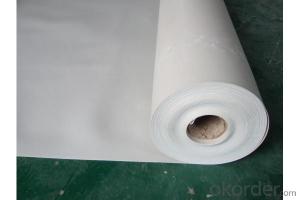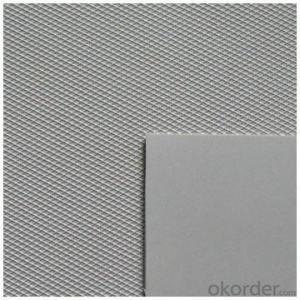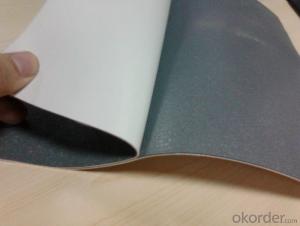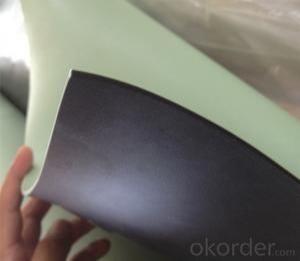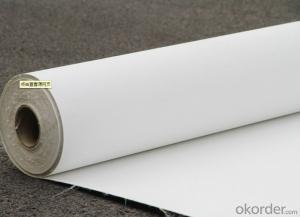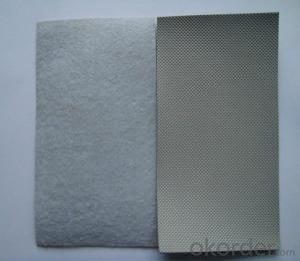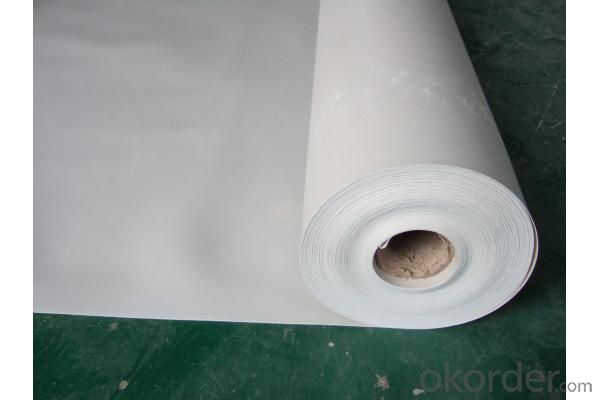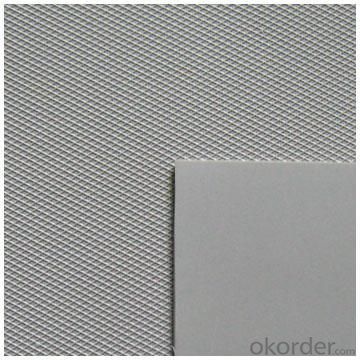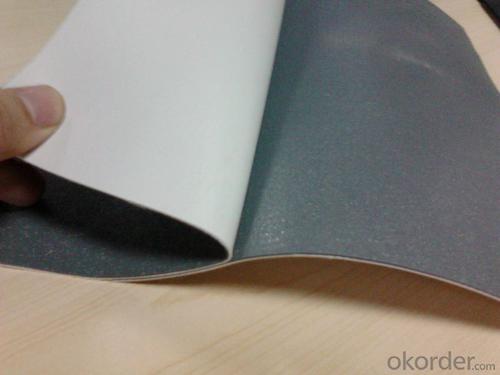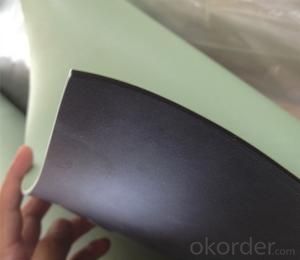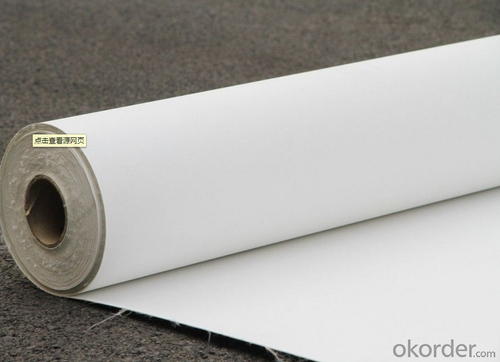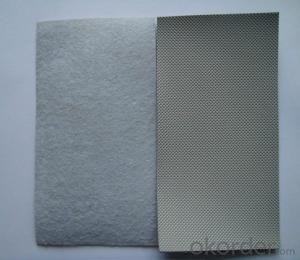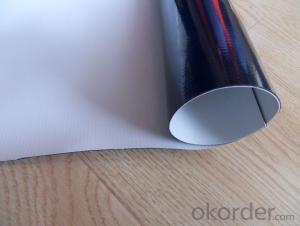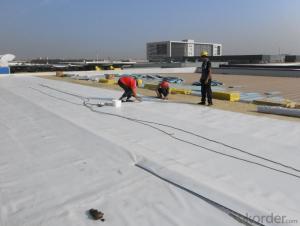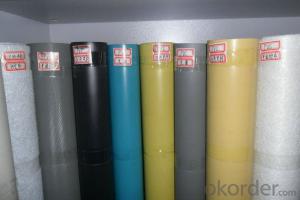PVC Waterproofing Membrane Reinforced with Fiberglass
- Loading Port:
- Shanghai
- Payment Terms:
- TT OR LC
- Min Order Qty:
- 20000 m²
- Supply Capability:
- 5000000 m²/month
OKorder Service Pledge
OKorder Financial Service
You Might Also Like
PVC Waterproofing Membrane Reinforced with Fiberglass
Product Description of PVC Waterproofing Membrane Reinforced with Fiberglass:
PVC waterproofing membrane is an excellent high-quality polymer waterproof sheet, made of PVC resin by adding plasticizer, anti-UV agent, anti aging agent, and stabilizer and other processing aids through extrusion and molding. As the highly recommended product by the Ministry of Construction, it is featured by high tensile strength, great elongation, good stability, small shrinkage, low-temperature performances, good resistance to weathering and root
penetration, and long service life.
Features of PVC Waterproofing Membrane Reinforced with Fiberglass:
1.Long service life and weathering resistance; and the materials can be used for 30 years on the roof and 50 years underground.
2. High tensile strength, great elongation, and small size change during heat treatment.
3. Good low temperature flexibility and adaptability to environmental temperature changes.
4. Good resistance to root penetration. It can be made for green roofs.
5. Excellent resistance to puncture and impact.
6. Convenient for construction (can be welded), solid and reliable, and Eco-friendly.
7. Strong resistance to chemical corrosion, suitable for special occasions.
8. Good plasticity, convenient and quick corner detail treatment. Easy maintenance and low cost.
9.After 2,000 hours of manual weathering verification
Classification of PVC Waterproofing Membrane Reinforced with Fiberglass:
1. N: Homogeneous PVC membrane
2. L: PVC membrane with fabric backing
3. W: Reinforced PVC membrane
Advantage of PVC Waterproofing Membrane Reinforced with Fiberglass:
1.) Mixing automation. Apply automatic temperature control automatic time control and automatic feed control.
2.) Extrusion equipment uses twin screw coextrusion. Screw temperature uses computer automatic temperature control system.
3.) Handpiece uses large width didhead extrusion equipment.
4.) Sophisticated three-roller calender equipment. The space between equiment is controlled by automation system.
Technical Data of PVC Waterproofing Membrane Reinforced with Fiberglass:
No. | Item | Model Ⅱ | |
1 | Tensile Strength Mpa ≥ | 12.0 | |
2 | Elongation at break% ≥ | 250 | |
3 | Shrinkage rate % ≤ | 2.0 | |
4 | Flexibility at low temperature | No crackle at -25oC | |
5 | Water tightness | Watertight | |
6 | Puncture resistance | Watertight | |
7 | Heat aging treatment | Appearance | Free from bubble, crack, cohesion and void |
Change rate of tensile strength % | +20oC | ||
Change rate of elongation at break | |||
Flexibility at low temperature | No crack at -20oC | ||
8 | Chemical corrosion resistance | Change rate of tensile strength % | +20 |
Change rate of elongation at break | |||
Flexibility at low temperature | No crack at -20oC | ||
9 | Artificial weathering | Change rate of tensile strength % | +20 |
Change rate of elongation at break | |||
Flexibility at low temperature | No crack at -20oC | ||
Application of PVC Waterproofing Membrane Reinforced with Fiberglass:
1) All kinds of roofs, such as steel structure roof, planted roof etc.
2) Underground engineering, such as building basement, subways, tunnels, air raid shelter, etc.
3) Other projects like artificial lake, dam, water reservoir, grain storehouse, etc.
Images of PVC Waterproofing Membrane Reinforced with Fiberglass:
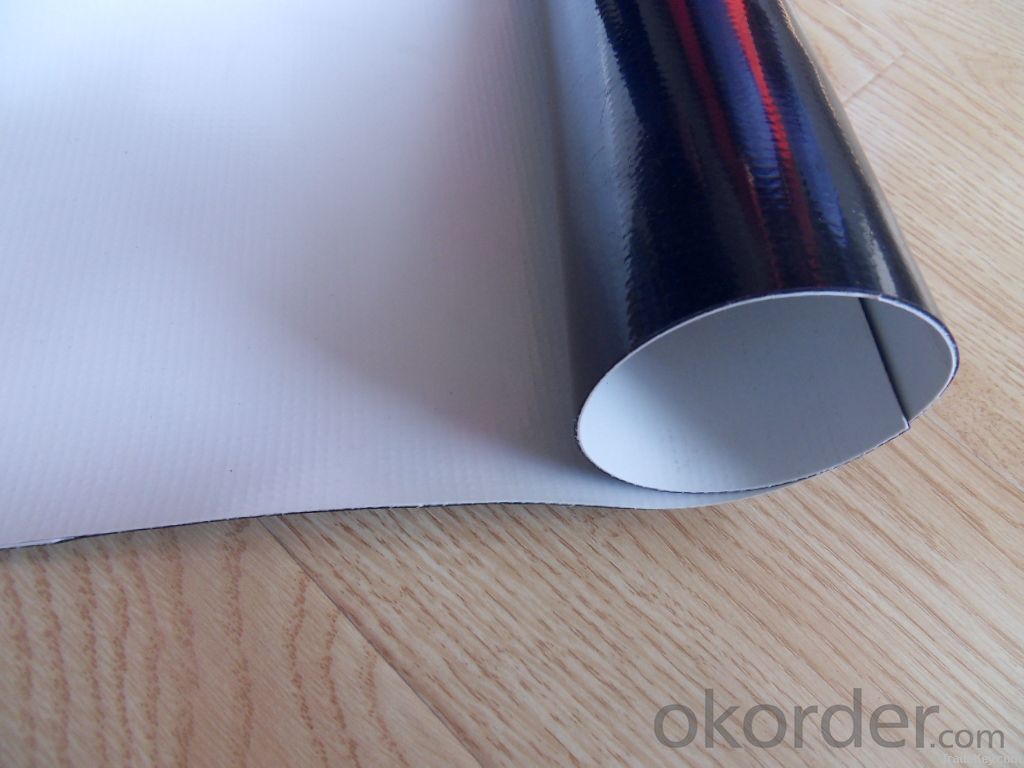
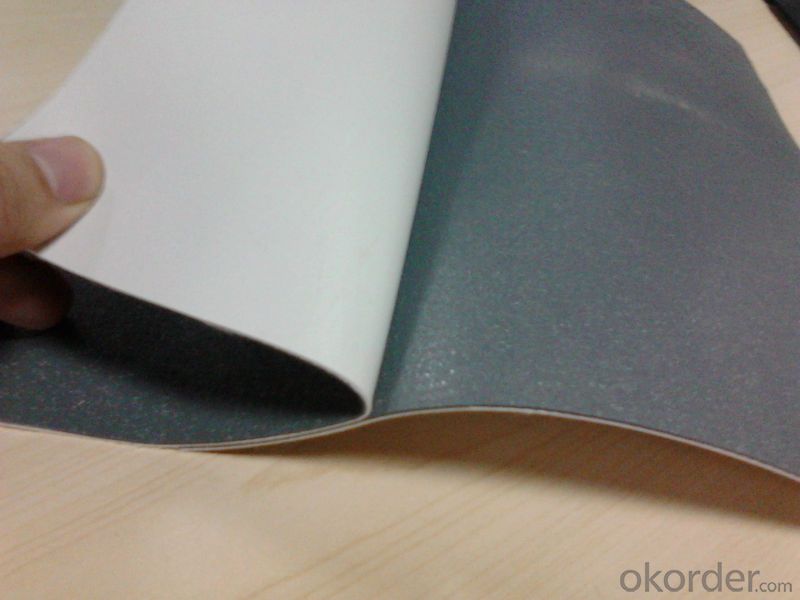
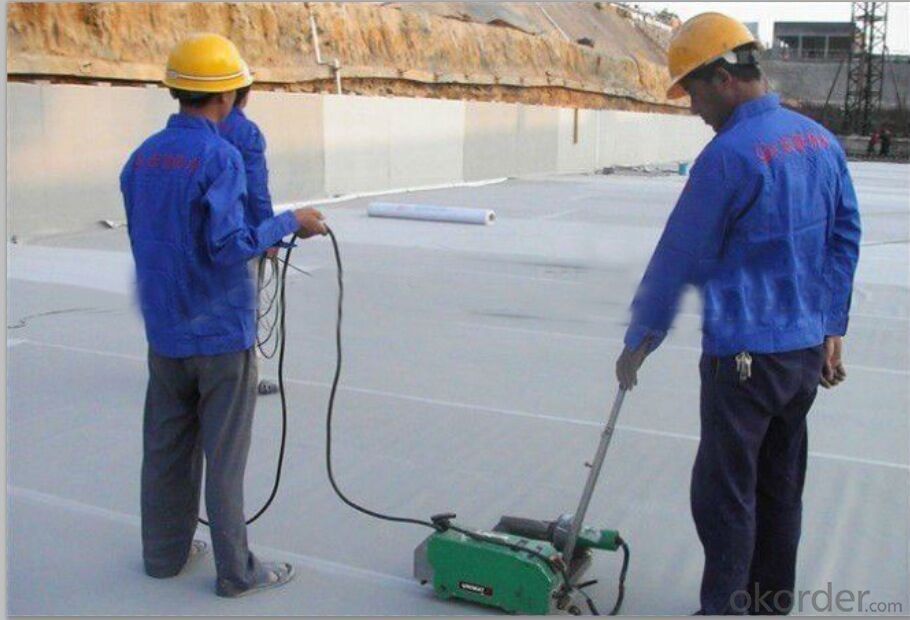
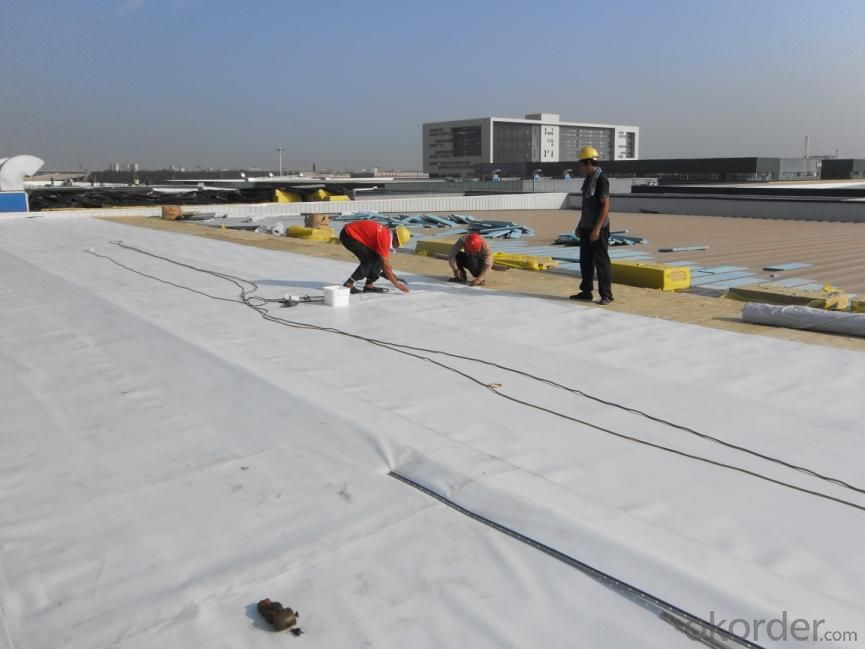
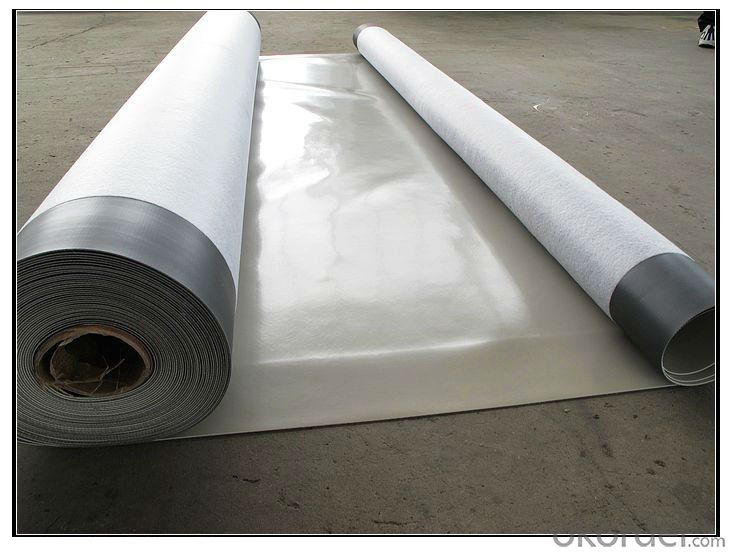
FAQ of PVC Waterproofing Membrane Reinforced with Fiberglass:
1. Can you produce 4m width?
Yes, no problem for us. We have four bases in China, largest one in this field.
2. How many quantity in one 20'' container for 1.2mm and 1.5mm?
480rolls, 11520m2 for 1.2mm and 400rolls, 9600m2 for 1.5mm
3. Can you provide free samples?
Yes, our samples are free, but express fees usually on buyer's account.
- Q: Can a waterproofing membrane be used in government or municipal projects?
- Yes, a waterproofing membrane can definitely be used in government or municipal projects. In fact, it is often a crucial component in the construction or renovation of various infrastructure projects such as roads, bridges, tunnels, and buildings. Waterproofing membranes help to prevent water infiltration, which can cause damage to the structure and compromise its integrity. By using a waterproofing membrane, government and municipal projects can ensure the longevity and durability of their infrastructure, reducing the need for costly repairs or replacements in the future. Additionally, waterproofing membranes can also contribute to energy efficiency by preventing moisture intrusion, thus reducing the potential for mold growth and improving insulation properties. Overall, the use of a waterproofing membrane in government or municipal projects is highly recommended to enhance the lifespan and functionality of the infrastructure.
- Q: Can a waterproofing membrane be used for underground utilities?
- Yes, a waterproofing membrane can be used for underground utilities. Waterproofing membranes are designed to provide a barrier against water penetration, protecting the underlying structure from moisture damage. This can be particularly important for underground utilities, as they are constantly exposed to the surrounding soil and potential water seepage. By applying a waterproofing membrane to underground utilities, such as water pipes, sewer lines, or electrical conduits, it helps prevent water infiltration and subsequent corrosion or degradation of the materials. The membrane acts as a protective layer, keeping the utilities dry and free from moisture-related issues. There are various types of waterproofing membranes available, including sheet membranes, liquid membranes, and spray-applied membranes, each with its own unique properties and installation methods. The choice of membrane will depend on factors such as the specific utility, surrounding soil conditions, and any additional requirements such as chemical resistance or structural reinforcement. It is important to note that proper installation and maintenance of the waterproofing membrane are crucial for its effectiveness. The membrane should be installed by trained professionals, following manufacturer guidelines and industry best practices. Regular inspections and maintenance should also be carried out to ensure the membrane remains intact and functional over time. In summary, a waterproofing membrane can indeed be used for underground utilities, offering protection against water infiltration and preserving the integrity and longevity of the utilities.
- Q: Can a waterproofing membrane be used on precast copper surfaces?
- Yes, a waterproofing membrane can be used on precast copper surfaces. Waterproofing membranes are versatile and can be applied on a variety of surfaces, including copper. These membranes are designed to create a barrier that prevents water penetration and protects the underlying structure from moisture damage. When applied correctly, a waterproofing membrane can effectively seal precast copper surfaces, providing long-lasting protection against water intrusion. However, it is important to ensure that the membrane is compatible with copper and that proper surface preparation is done before application to ensure optimal adhesion and performance.
- Q: Can a waterproofing membrane be used for a balcony deck?
- Indeed, a balcony deck can be protected by utilizing a waterproofing membrane. It is a highly recommended solution for shielding balcony decks against water damage. The primary purpose of a waterproofing membrane is to establish a barrier that hinders the infiltration of water into the underlying structure. It effectively safeguards the deck from various moisture-related problems such as rot, mold, and deterioration. This membrane is typically applied in either liquid or sheet form, effectively covering the entire surface of the balcony deck to create a seamless and impenetrable layer. Acting as a shield, this membrane ensures that any water coming into contact with the deck is effectively repelled and diverted away. By incorporating a waterproofing membrane, you can successfully prolong the lifespan of your balcony deck and uphold its structural integrity for many years to come.
- Q: Can a waterproofing membrane be used on tunnels?
- Yes, a waterproofing membrane can be used on tunnels. Tunnels are often subjected to high levels of moisture, groundwater infiltration, and potential leaks. Therefore, it is crucial to protect them from water damage and ensure their long-term structural integrity. Waterproofing membranes are commonly used in tunnel construction to prevent water penetration and provide an effective barrier against moisture. These membranes are designed to be durable, flexible, and resistant to various environmental conditions, making them suitable for use in tunnels. They can be applied to the tunnel walls, roof, and floor to create a waterproof seal, ensuring that the tunnel remains dry and protected from water-related issues such as corrosion, deterioration, and mold growth. Additionally, waterproofing membranes can also help in reducing maintenance costs and extending the lifespan of the tunnel infrastructure.
- Q: What is the use of waterproof membrane?
- Building waterproofing membrane is mainly used for building walls, roofs, tunnels, highways, landfills, etc., to withstand external rain, groundwater leakage can be curled into a roll of flexible building materials.
- Q: Can waterproofing membranes be installed on uneven surfaces?
- Yes, waterproofing membranes can be installed on uneven surfaces. In fact, one of the advantages of waterproofing membranes is their ability to conform to various irregularities and unevenness in the surface. These membranes are typically flexible and can be easily molded and adjusted to fit the contours of the substrate. Additionally, some waterproofing membranes have self-adhesive properties or can be applied with adhesives, allowing them to adhere to both smooth and uneven surfaces effectively. However, it is important to note that proper surface preparation is crucial for a successful installation. The surface should be clean, dry, and free from any loose materials or debris to ensure optimum adhesion and performance of the waterproofing membrane.
- Q: Can a waterproofing membrane be used on precast concrete block surfaces?
- Yes, a waterproofing membrane can be used on precast concrete block surfaces. Waterproofing membranes are commonly used to protect below-grade structures, such as basements and foundations, from water intrusion. Precast concrete blocks are commonly used in the construction of these structures, and applying a waterproofing membrane can help prevent water from penetrating through the concrete and causing damage. The membrane acts as a barrier, preventing the passage of water while still allowing the concrete to breathe and release any moisture buildup. Additionally, waterproofing membranes can also help improve the overall durability and longevity of the precast concrete blocks by protecting them from moisture-related issues such as cracking, spalling, and corrosion. It is important to choose a waterproofing membrane that is specifically designed for below-grade applications and is compatible with concrete surfaces to ensure proper adhesion and long-term effectiveness.
- Q: Can waterproofing membranes be used on outdoor fountains?
- Yes, waterproofing membranes can be used on outdoor fountains. Waterproofing membranes are designed to create a barrier that prevents water from penetrating through surfaces, making them ideal for protecting outdoor fountains from water damage. These membranes are typically made of materials such as rubber, PVC, or bitumen, which are highly resistant to water and can effectively seal the fountain's structure. Applying a waterproofing membrane to an outdoor fountain can help prolong its lifespan, prevent leaks, and protect it from the elements.
- Q: What is rigid waterproof, flexible waterproof?
- 1, rigid waterproof means that: waterproof layer by the tensile force is greater than the tensile strength of waterproof materials (including settlement deformation, temperature deformation, etc.), waterproof layer of brittle cracking caused by leakage of water, known as rigid waterproof. (Especially the "water leakage" waterproof layer), waterproof concrete mortar waterproof layer, thin layer of inorganic rigid waterproof layer (such as "water leakage" waterproof layer), and so on.
Send your message to us
PVC Waterproofing Membrane Reinforced with Fiberglass
- Loading Port:
- Shanghai
- Payment Terms:
- TT OR LC
- Min Order Qty:
- 20000 m²
- Supply Capability:
- 5000000 m²/month
OKorder Service Pledge
OKorder Financial Service
Similar products
Hot products
Hot Searches
Related keywords
